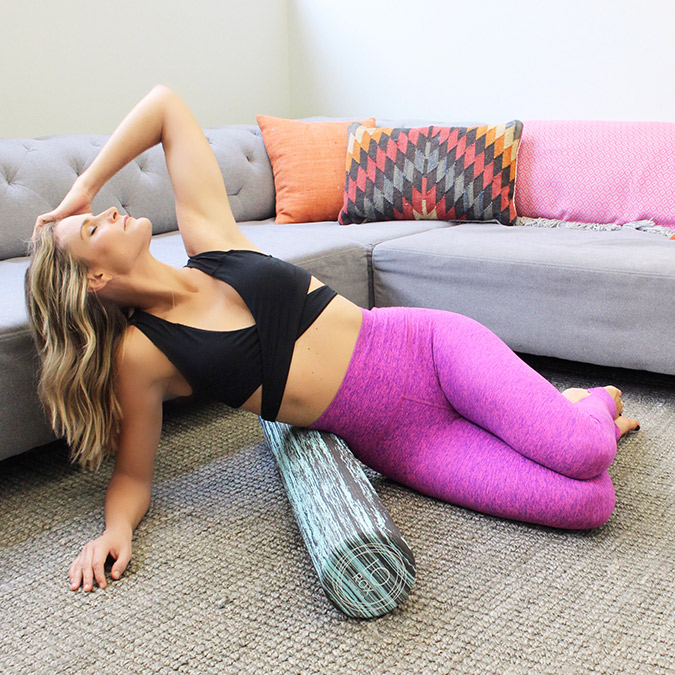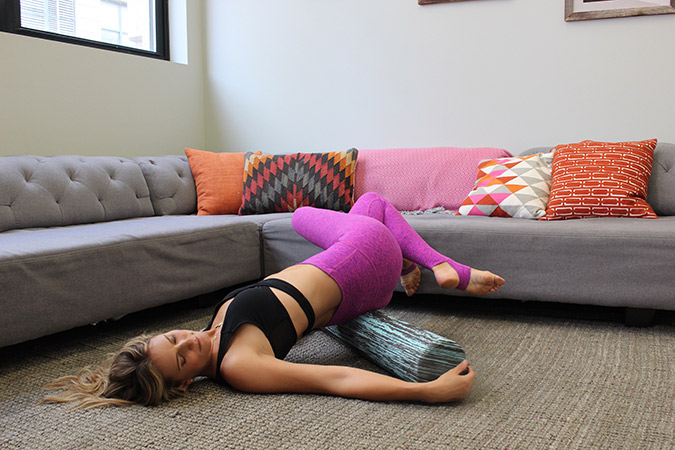Oh Baby: Top Tips for the 4th Trimester, Part 1

Today’s post is coming from our girl Lauren Roxburgh. She’s an author of ‘Taller, Slimmer, Younger – 21 Days to a Foam Roller Physique’, founder of Be Aligned by Lauren Roxburgh, creator of the Lo Rox Aligned Rollers and the Be Aligned video series. Certified in fields of Structural Integration, classical Pilates, nutrition and pre/post-natal yoga, Lauren is a body worker, trainer and fascia and alignment expert who works with some of the world’s top athletes and celebrities. She’s also a friend of Team LC’s, and is sharing some very important information below for all of the new mamas out there…
Hi everyone, it’s Lauren Roxburgh here! Getting pregnant is one of the biggest occasions in any woman’s life. Take it from someone who’s been through the process twice. As soon as you see those two lines on the stick or get the exciting news from your doctor, your focus narrows down to the next 40-odd weeks until you give birth and beyond. You’ll also soon learn that everyone (and I mean everyone) will have advice on what happens to your body during those three trimesters of your pregnancy and during birth.
But what happens after that? The three-month period after you give birth is often called the “4th Trimester.” For your baby, this period is almost an extension of life in the womb. It’s a crucial time as the development he or she experiences during those first few months of being out in the world are just as important as the development that took in your womb. But what about you, the mama? Almost all your focus is on your beautiful baby and it’s very easy to forget about yourself as you stumble through your days alternating between feeling blissed out and loved up before swinging to feeling like a sleep-walking dairy delivery machine. But here’s the thing—looking after yourself during the 4th Trimester is just as important as looking after your new baby. Because, let’s face it, if you don’t look after yourself you can’t properly look after your baby.
These are my top tips for looking after you during the 4th Trimester. I’ve split these tips into two parts because for new mamas the 4th Trimester is also split in two. First, there’s the 6-week period immediately after the birth when you are still recovering from childbirth and won’t be able to work out. This post outlines my top tips for this first 6-week period, which is all about bonding with your baby and looking after yourself as you get to grips with breastfeeding and looking after your new bundle of joy.
Honoring the first 40 days of a baby’s life is key. This period used to be known by the slightly off-putting term “confinement,” but the idea behind the name is solid. A new mother wasn’t expected to do anything other than stay at home and bond with her baby. Unfortunately, in the U.S. we are a long way behind many other countries in terms of what is considered standard post-natal leave and all too often new mothers are often expected to bounce back and quickly return to doing all the things they were doing before they were pregnant, including going back to work.
My first piece of advice here is to do whatever it takes to just chill out for at least 40 days and focus on your baby and yourself. As a new mother you need support, nurturing, love, and most of all no expectations to be doing anything than focusing on being a new mother. During these 40 days, don’t be afraid to ask for help. Make sure to take naps and make rest a priority. Listen to your body and eat what you feel you need. Your body is trying to produce enough milk to sustain another human being and it will tell you what it needs. Be kind to yourself. And despite the sleeplessness, make sure you treasure this time because as cliché as it sounds, it goes all too quickly.
All that being said, here are my top 10 tips for getting you through the first six weeks. Be sure to come back next week for my top 10 tips for the second half of your 4th Trimester…
1. Vital Vitamins
Taking a vitamin supplement during and after pregnancy is a good idea. Your body is going through massive changes and doesn’t always get all the vitamins and minerals it needs because so much is going to the baby. Some women continue to take their prenatal vitamins, but after pregnancy when you’re breastfeeding you have different nutritional needs. So, a vitamin supplement that is actually designed for this postnatal period is good idea. These often contain higher amounts of key vitamins including A, C, D and E as well as B vitamins to support cellular energy production and help meet the increased energy demands you’ll experience. Good post-natal vitamins also include DHA, the omega-3 fatty acid that may help support brain and eye development while nursing your baby. It can also help replenish your brain and rebalance your nervous system.
2. Dem Bones
Bone broth is going through a bit of a renaissance right now, but it’s actually something that’s been around forever. Because it is rich in collagen and gelatin, bone broth helps to build to strong bones, tendons and connective tissue in both mom and baby. It also supports the immune system by strengthening the gut lining and can help brain function by improving memory, sleep and mood. It can even help ward off “baby brain,” or that brain fog you get with the lack of sleep a newborn baby often causes. Plus, bone broth is also considered a beauty nutrient that helps with luxurious, strong hair and nails. So what’s not to like about bone broth in your 4th Trimester? I like to add fresh ginger, turmeric, black pepper and Himalayan salt to mine for an anti-inflammatory boast!
3. Do what with the Placenta?
This tip might sound a little strange to some of you, but the custom of consuming the placenta—also known as “placental encapsulation”—is actually many centuries old and is practiced in many traditions, most often in Chinese medicine. Don’t worry, it’s not quite as scary as it sounds. These days the placenta is dried, ground and made into pills that you then pop just like a multivitamin. The benefits are said to include releasing the hormone oxytocin, which helps the uterus return to its normal size, increasing the release of CRH which is a stress-reducing hormone, increasing milk production, and even decreasing postpartum depression. To be fair, it’s not without controversy in the U.S., but the practice has been gaining traction for the last couple of decades. While the few scientific studies that have been done on placental encapsulation don’t conclusively support the practice, they also don’t dispel the possibility of getting these benefits. The bottom line is there is no risk in doing this and the cost is relatively small (roughly $200-300). It really has helped me!

4. The Milky Way
While staying hydrated is important at any time, if you are breastfeeding it is vital. Normally you should be drinking about 64 ounces of water a day, or eight glasses a day. But breast milk production significantly increases a mother’s water loss, so you should be drinking about 100 ounces of water a day while you’re breastfeeding to keep hydrated. A good tip is to drink an 8-ounce glass every time you breastfeed, which is usually eight to 10 times a day. Another great way to ensure you’re hydrating is to drink a breast-feeding tea or tonic, I love More Milk Plus and Liquid Gold Tea. These have herbs such as fenugreek, blessed thistle, fennel, stinging nettle, goat’s rue, alfalfa, milk thistle, anise, marshmallow root, red raspberry leaf, coriander, caraway, and verbena—all of which can help increase your milk production. An easy-to-eat food that is meant to increase milk production is warm oatmeal. I know it’s worked for me, so change it up and try ‘sowing some oats’ in the morning.


5. Roll with It
Although you technically shouldn’t work out during this first six weeks after giving birth, you can start gently doing some restorative self-massage and foam rolling is my favorite. It’s the perfect way to heal and restore your body after the trauma of giving birth and being pregnant for so many months. I created a series of videos of roller workouts as well as diet, mindfulness and other wellness tips to keep you in shape through every stage of your pregnancy and the 4th Trimester. You can find it here.
6. Wrap That Belly
The Belly Bandit is basically a wrap you tighten around your stomach that helps shrink and balance your belly, waist, and hips post pregnancy. The idea is that these girdle-like wraps essentially shrink wrap the tummy which is thought to ease the swelling of the uterus while supporting the legs and the back. Like many of these tips, the idea of wrapping the tummy after giving birth is actually a very old concept, but modern belly wraps like the Belly Bandit with the Velcro adjustment make them easy and effective to use. I’ve used them after both of my pregnancies and I swear by them. In fact I recommend wearing one for the first month or six weeks after giving birth as much as possible.
7. Miracle Magnesium
Magnesium is vital for overall health and plays a significant role in hydration, muscle relaxation, decreasing stress, energy production and crucially, the deactivation of adrenaline. This is important for breastfeeding moms because adrenaline is a stress hormone, which means it can interfere with the production and let down of milk. Plus, magnesium is a natural sleep aid, and getting good sleep is key during the 4th Trimester (even though you’ll probably feel as if you’re never quite getting enough!). Unfortunately, it is estimated that 80% of people don’t get enough magnesium, so taking a supplement is a great way to make sure you’re getting enough. I love the Natural Vitality Calm powder because it’s easy to take, dissolves in water, is virtually tasteless, and comes in several great tasting flavors. Check it out here for a free sample.
8. Healing Down There
Of course the female body is made to have babies, but it’s still a pretty traumatic physical process whether you have a C-section or vaginal birth. Everything happening down in your lady parts can lead to incontinence and a loss of connection to the pelvic floor in many new mamas. A super helpful tip to rebuild the tone and connection down there is to start reconnecting to this area by cutting off your pee mid-stream when you are on the toilet. To do this, contract, pull up, and hold, and the pee should stop. It may be difficult to do this at first, but keep trying and it will improve dramatically. You should feel a tightening around your vagina, though try not to tighten your butt or upper belly muscles. Contrast this move by letting go of the muscles. Feel the base of the core relax, and then relax one more layer to fully surrender. Learning to isolate and relax these muscles helps us in moments of stress because you’ll be able to relax this area where we hold onto stress. I know it sounds funny, but another great way to reconnect to your pelvic floor is to try peeing in the shower in a deep squat position to fully empty the bladder. When you fully squat to pee as opposed to sitting up straight on the toilet, you automatically engage your pelvic floor and it naturally stretches, strengthens, and tones.
9. Meditate Your State
Meditation can dramatically impact your state of mind, and that can help your entire household. Meditation has been scientifically proven to help release stress and decrease tension, and when you are calm and happy the baby will be too. There are plenty of courses and resources online to help you learn, plus there are some great apps for meditation these days. Just remember that it’s not complicated. Close your eyes and just focus on your breath going in and out and you’re basically meditating. Find a mama mediation buddy so you can watch each other’s babies while you each meditate. I like to meditate first thing in the morning in bed, before anyone gets up, or when I’m breastfeeding, even if it’s just for five minutes. It truly helps. Find my quick meditation here.
I also like to practice a quick breathing exercise after meditating to rebalance the pelvis, organs, and waistline. Stand sideways in front of the mirror, inhale through your nose and fill up your lungs 3-dimensionally as you pull your belly and pelvic floor up and in to help bring the pelvis, hips, organs and abdominal muscles back into alignment. Then exhale through your mouth like you’re steaming up a window and repeat 10 times each day.

10. Body Love = Self Love
Giving your body and yourself a little love is OK. In fact, it’s vital to help you feel good about yourself in these first few weeks. Don’t be afraid to take a few precious moments each day to pamper yourself. A couple of my favorite things include dry brushing, which is one of the easiest and least expensive ways to stimulate your lymphatic system (which serves as the circulatory system’s waste removal system) and to flush toxins, especially from the legs, hips and belly. Dry brushing also stimulates the connective tissue attached to the capillaries sitting under your skin, which improves circulation through the body. To brush, I like to use a natural fiber body brush by Mio. Start at the feet and brush your way up your inner and outer legs to your hips, waist, tummy, backs of the arms, chest, back, and shoulders, always moving the brush in the direction of your heart. Also, for the sake of your sanity, accept some help and make sure you take some time to go get a blowout, a massage, or a pedicure. Taking a mini break can work wonders on your body and soul when it all feels too much. And when those nighttime feedings are taking their toll, these amazing Skyn Face Gels melt away the wrinkles and lines and at least leave you looking and feeling refreshed.
I hope these tips work for you! Be sure to check back next week for my top 10 tips for the second half of your 4th Trimester, which is all about starting to get yourself back in shape and your body back in alignment, including rebuilding your deep core and pelvic floor, shrinking the waist back in and re-aligning your spine, hips and entire body and mind.
Do any of the mamas out there have any 4th Trimester advice?
Let us know in the comments!
A big thank you to Lauren for contributing this super helpful and informative post. For more, be sure to check out Lauren’s website by clicking here.
XO Team LC
Photos: Lauren Roxburgh
